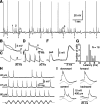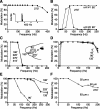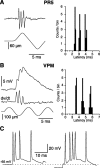The relay of high-frequency sensory signals in the Whisker-to-barreloid pathway
- PMID: 12890771
- PMCID: PMC6740730
- DOI: 10.1523/JNEUROSCI.23-17-06778.2003
The relay of high-frequency sensory signals in the Whisker-to-barreloid pathway
Abstract
The present study investigated the operational features of whisker-evoked EPSPs in barreloid cells and the ability of the whisker-to-barreloid pathway to relay high rates of whisker deflection in lightly anesthetized rats. Results show that lemniscal EPSPs are single-fiber events with fast rise times (<500 microsec) that strongly depress at short inter-EPSP intervals. They occur at short latencies (3.84 +/- 0.96 msec) with little jitters (<300 microsec) after electrical stimulation of the whisker follicle. Waveform analysis indicates that one to three lemniscal axons converge on individual barreloid cells to produce EPSPs of similar rise times but different amplitudes. When challenged by high rates of whisker deflection, cells in the whisker-to-barreloid pathway demonstrate a remarkable frequency-following ability. Primary vibrissa afferents could follow in a phase-locked manner trains of sinusoidal deflections at up to 1 kHz. Although trigeminothalamic cells could still faithfully follow deflection rates of 200-300 Hz, the actual frequency-following ability of individual cells depends on the amplitude, velocity, and direction of displacements. The discharges of trigeminothalamic cells induce corresponding phase-locked EPSPs in barreloid cells, which trigger burst discharges at stimulus onset. During the following cycles of the stimulus train, few action potentials ensue because of the strong synaptic depression at lemniscal synapses. It is concluded that the whisker-to-barreloid pathway can relay vibratory inputs with a high degree of temporal precision, but that the relay of this information to the cerebral cortex requires the action of modulators, and possibly phase-locked discharges among an ensemble of relay cells.
Figures










Similar articles
-
Adaptation in thalamic barreloid and cortical barrel neurons to periodic whisker deflections varying in frequency and velocity.J Neurophysiol. 2004 Dec;92(6):3244-54. doi: 10.1152/jn.00257.2004. Epub 2004 Aug 11. J Neurophysiol. 2004. PMID: 15306632
-
Dendroarchitecture and lateral inhibition in thalamic barreloids.J Neurosci. 2004 Jul 7;24(27):6098-105. doi: 10.1523/JNEUROSCI.0973-04.2004. J Neurosci. 2004. PMID: 15240801 Free PMC article.
-
Intrinsic firing patterns and whisker-evoked synaptic responses of neurons in the rat barrel cortex.J Neurophysiol. 1999 Mar;81(3):1171-83. doi: 10.1152/jn.1999.81.3.1171. J Neurophysiol. 1999. PMID: 10085344
-
Effects of neonatal C-fiber depletion on the integration of paired-whisker inputs in rat barrel cortex.Exp Brain Res. 2005 Mar;162(1):115-21. doi: 10.1007/s00221-004-2118-4. Epub 2004 Nov 13. Exp Brain Res. 2005. PMID: 15551079
-
Local field potentials and the encoding of whisker deflections by population firing synchrony in thalamic barreloids.J Neurophysiol. 2003 Apr;89(4):2137-45. doi: 10.1152/jn.00582.2002. Epub 2002 Dec 27. J Neurophysiol. 2003. PMID: 12612019
Cited by
-
Hierarchy of orofacial rhythms revealed through whisking and breathing.Nature. 2013 May 9;497(7448):205-10. doi: 10.1038/nature12076. Epub 2013 Apr 28. Nature. 2013. PMID: 23624373 Free PMC article.
-
Rapid Cortical Adaptation and the Role of Thalamic Synchrony during Wakefulness.J Neurosci. 2021 Jun 23;41(25):5421-5439. doi: 10.1523/JNEUROSCI.3018-20.2021. Epub 2021 May 13. J Neurosci. 2021. PMID: 33986072 Free PMC article.
-
Complementary processing of haptic information by slowly and rapidly adapting neurons in the trigeminothalamic pathway. Electrophysiology, mathematical modeling and simulations of vibrissae-related neurons.Front Cell Neurosci. 2013 Jun 4;7:79. doi: 10.3389/fncel.2013.00079. eCollection 2013. Front Cell Neurosci. 2013. PMID: 23761732 Free PMC article.
-
Self-motion and the shaping of sensory signals.J Neurophysiol. 2010 Apr;103(4):2195-207. doi: 10.1152/jn.00106.2009. Epub 2010 Feb 17. J Neurophysiol. 2010. PMID: 20164407 Free PMC article.
-
A unifying framework underlying mechanotransduction in the somatosensory system.J Neurosci. 2011 Jun 8;31(23):8520-32. doi: 10.1523/JNEUROSCI.6695-10.2011. J Neurosci. 2011. PMID: 21653856 Free PMC article.
References
-
- Ahissar E, Sosnik R, Haidarliu S ( 2000) Transformation from temporal to rate coding in a somatosensory thalamocortical pathway. Nature 406: 302-306. - PubMed
-
- Alonso JM, Usrey WM, Reid RC ( 1996) Precisely correlated firing in cells of the lateral geniculate nucleus. Nature 383: 815-819. - PubMed
-
- Bae YC, Ihn HJ, Park MJ, Otterson OP, Moritani M, Yoshida A, Yoshio S ( 2000) Identification of signal substances in synapses made between primary afferents and their associated axon terminals in the rat trigeminal sensory nuclei. J Comp Neurol 418: 299-309. - PubMed
-
- Bloomfield SA, Sherman MS ( 1988) Postsynaptic potentials recorded in neurons of the cat's lateral geniculate nucleus following electrical stimulation of the optic chiasm. J Neurophysiol 60: 1924-1945. - PubMed
Publication types
MeSH terms
LinkOut - more resources
Full Text Sources
